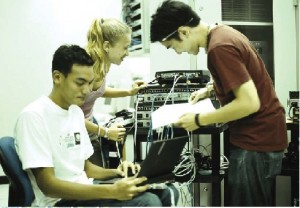Cisco Network Academy Program
 Cisco Systems runs theCisco Networking Academy Program through a highly successful alliance between Cisco System, education, business, government and communities to create a pool of trained manpower that can addressed the growing need of networking professionals in a globalised world.
Cisco Systems runs theCisco Networking Academy Program through a highly successful alliance between Cisco System, education, business, government and communities to create a pool of trained manpower that can addressed the growing need of networking professionals in a globalised world.
over 41,000 networking professionals during 2005-10, driven by regulatory compliance. Telecom sector, which currently accounts for around 16% of the total demand of networking professionals, is expected to witness an additional demand of over 75,000 professionals during 2005-10. BPO/ITES is the segment will witness the highest growth in the demand with a CAGR of 35% during the period 2005-10. Due to an increase in technology adoption, the demand for networking professionals in the governance and the retail sector is also expected to increase considerably.
Cisco Networking Academy Program- a response to global needs
Cisco Systems, Inc. is the worldwide leader in networking for the Internet. Today, networks are an essential part of business, education, government and home communications, and Cisco Internet Protocol-based (IP) networking solutions are the foundation of these networks. Cisco Systems runs the Cisco Networking Academy Program (CNAP), a timely response to such challenges in India and around the world. It is a highly successful alliance between Cisco Systems, education, business, government, and communities. Through an innovative partnership with educational institutions across the world, the CNAP is a world wide philanthropic rogram (part of Cisco’s corporate social responsibility initiative) aimed at creating a pool of trained manpower that can address the growing need of networking professionals. The CNAP offers a solution to address he need for greater technology literacy. In developing and emerging markets, the content and learning methodologies provide a significant step forward in education and opportunity for participating students. The key promise: a way to spur growth in a global economy that places high value on technology leaders. Since its launch in 1997, the program
has grown to more than 10,000 worldwide academies in over 160 countries, with curriculum taught in nine different languages. Over 1.6 million students participate in academies operating in high schools, colleges and universities, technical schools, community-based organizations, and other educational programs around the world. The program objectives and modules
The program empowers people
through e-Learning environments that enable them to learn anytime, anywhere, at their own pace, and with more targeted assessments and accountability than traditional classroom settings. It is an e-Learning model that delivers web-based educational content developed by networking and education experts, online assessment, student performance tracking, instructor training and support, as well as preparation for industry standard certification. It provides educational institutions with leading-edge IT curricula and hands-on lab exercises to train a workforce that may attract highly desirable technology employers. One of the most popular courses, Cisco Certified Networking Associate (CCNA) is a complete, four-module program on the principles and practice of designing, building, and maintaining networks capable of supporting national and global organizations. The Cisco Networking
Academy Program is in line with needs of colleges, and features hands-on, project-driven training in high-demand job skills. It incorporates an e-Learning system that includes multimedia curricula, online testing, performance-based skills assessment, and classroom management through a Web interface. The Networking Academy program also offers courses sponsored by Hewlett-Packard and Panduit Corp. as a part of the overall basket of course offerings. The sponsored curriculum enhances IT competencies throughout the the program and, by broadening its scope, offer more students the opportunity to take advantage of the program.
Cisco partnering for education
There are several successful examples of the positive impact of the Cisco Networking Academy Program on arious countries/economies. One of them is the Jordan Education Initiative for which Cisco Systems was awarded last year’s US Award for Corporate Excellence. The Jordan Education Initiative (JEI), an ambitious e-Learning project, is helping improve Jordan’s educational foundation and establish an Internetenabled learning model that can be replicated around the globe. CiscoSystems President and CEO John T. Chambers proposed the idea of creating the JEI at the January 2003 World Economic Forum (WEF) meeting in Davos, Switzerland, as a way for companies to join forces with government and nonprofit organizations to create a technologybased education program. Cisco and the WEF, along with World Links (a Washington, D.C.- based organization devoted to using the Internet to improve education), and several Jordanian ministries, launched the JEI five months later. The Jordan Education Initiativesupports the Jordanian government’s vision of building a knowledge-based economy by providing lifelong earning opportunities for all citizens. The JEI’s broad application of elearning, hardware, curricula, and training is already transforming education in public schools throughout the country. The Jordan Education Initiative has set the stage for similar initiatives to be replicated in other parts of the world. One such initiative is Cisco Systems’ partnership with the Indonesian Government. Indonesia’s efforts to produce a whole new generation of IT professionals with a strong foundation in networking and the Internet received a major boost in 2004. Cisco Systems and the Indonesian Ministry of Education signed an agreement to extend the Cisco Networking Academy Program to 400 vocational schools across the country, in an initiative spearheaded by the Directorate of Technical and Vocational Education to support Indonesia’s economic growth and public and private sector requirements. Another example is the Rajasthan Education Initiative (REI) that was aunched in November 2005. A Memorandum of Understanding(MOU) was signed between Government of Rajasthan, India and Cisco Systems, to introduce the Networking Academy Program to 32 district computer education centers. Cisco will initially provide training to 100 teachers, who in turn will train 3200 students with fundamental IT skills in the first year of the project. As part of the initiative, Cisco will also provide consulting services on networking and security aspects for connectivity within the Education Department Computerization Program and its data center to link locationswithin the state. The key demographic groups that the REI will focus include: girl children, rural children, urban underprivileged children, children with special needs. Outside of REI, Cisco has setup more than 130 Networking Academies across 20 States and Union Territories, with more than 6000 active
students. These academies look to bridge the digital and gender divide in the country by providing career opportunities to aspiring students in the networked digital economy. The networking academies include institutes like IIIT Bangalore, Anna University, Amrita Vishwa Vidyapeetham, Guru Gobind
Indraprastha University, IMT Ghaziabad, PNB Institute of Information Technology and several government polytechnics. There are also six academies that impart networking and basic IT essentials education to women. The academies are in Jaipur, New Delhi, Pune, Kerala and Himachal Pradesh. Other countries where the Cisco Networking Academy Program is running successfully in the Asia Pacific region include China with 219 Academies and 12,445 students, Australia with 212 academies and 8,732 students and Philippines with 136 academies and 26,990 students among others.
Looking ahead
The Cisco Networking Academy Program is playing a key role in building technical human capacity across the world, especially developing nations. It is roviding new opportunities to countries and individuals to participate in the digitally networked economy. Cisco will continue to work with governments round the world to expand the reach of the program. It will also keep evolving the curriculum to keep pace with technological advancements and extend it to new areas/technologies such as IP telephony and wireless among others. ?
























